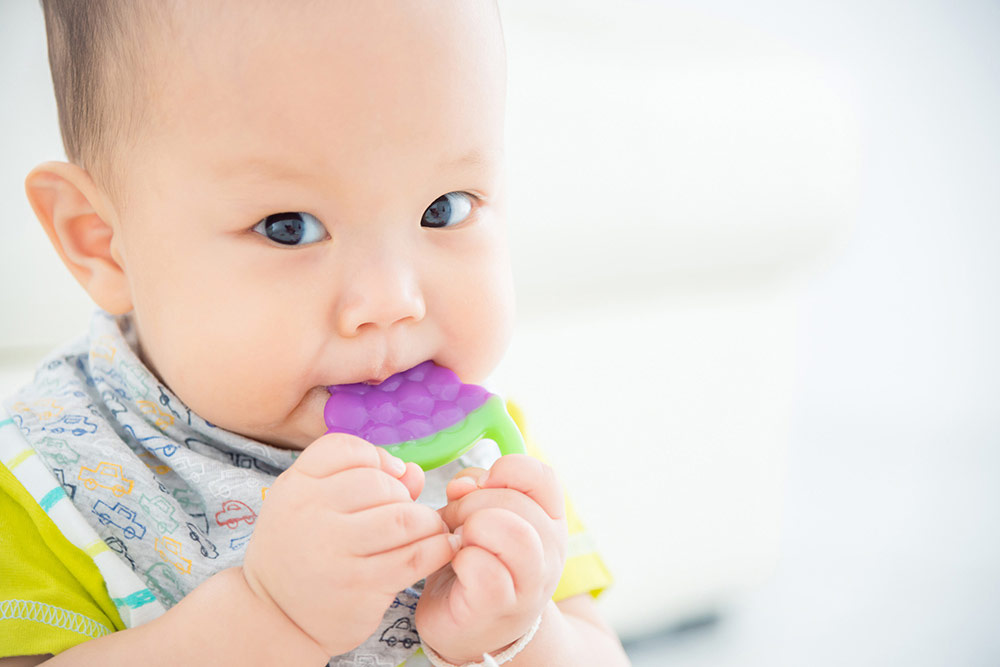All About Teething

Spot the beginning stages of teething, plus how to provide relief for baby's less-gummy grin.
Robert L. Delarosa, DDS, founding partner of Associates in Pediatric Dentistry and a pediatric dentist in Baton Rouge, Louisiana, shares what parents need to know before tiny teeth start sprouting.
When do babies start teething?
Timing of teeth eruption varies for all children, but usually the two lower front teeth (central incisors) make an appearance by 6 months of age. There are some babies born with these teeth, and others may not get them until closer to their first birthday. Female primary teeth often appear before males’ teeth as well, so it’s definitely possible that a 4-month-old female would be in the beginning stages, especially if showing signs of teething.
What are the signs and symptoms?
Teething is the natural process of tooth eruption in the gum line. Symptoms usually begin about two to five days before a tooth appears, and most often stop once the tooth emerges through a baby’s gums. However, in some babies, symptoms can persist off and on for up to two months after the tooth has broken through.
The most common symptoms of teething are discomfort, sore gums, swelling where a tooth will erupt, as well as drooling from increased saliva flow. These symptoms tend to be worse at night.
Other reported symptoms that may be teething related are fussiness, cough and congestion, runny nose, sleep disturbance, decreased appetite, loose stools, vomiting and low-grade fever. However, if these symptoms persist beyond a few days or worsen, then it is advisable to have other possible causes ruled out by your child’s pediatrician.
How uncomfortable is it for my baby?
The experience of teething varies greatly amongst little ones. The fortunate ones have almost no issues while others will experience a fairly rough time getting teeth in.
You may notice that some teeth bother your child more than others. More often than not, baby’s first tooth can be very painful, especially since the sensation is new in baby’s mouth. The molars also cause greater discomfort because they are larger than other teeth. Once your child becomes accustomed to the teething process, they should be able to handle the pain a bit better and may show less signs of being bothered.
It’s helpful to know that baby teeth tend to erupt in a symmetrical pattern, with the lower teeth emerging before upper teeth and front teeth coming in before back teeth. The complete arrival of a full set of all 20 baby teeth can take up to three years, with the typical pattern being central incisors (6-12 months), lateral incisors (9-16 months), first molars (13-19 months), canines (16-23 months) and second molars (23-33 months).
What can I do help?
Treatment for teething pain most often includes gently massaging tender gums with a clean finger, gauze or wet washcloth. Cool fluids and other cold items such as ice cream or yogurt and pudding can also help soothe teething pain. If teething rings or other teething toys are used, try chilling them to help numb the gums.
Note that the Food and Drug Administration (FDA) discourages the use of over-the-counter and prescription topical teething gels, creams or homeopathic teething tablets to reduce discomfort, citing little to no benefit and association with serious risk. The ingredient benzocaine is an anesthetic found in many of these products and can cause a rare but serious (and occasionally fatal) condition called methemoglobinemia, where baby’s oxygen levels drop to a dangerous level.
Teething is a normal part of your baby’s growth and development, and as with most phases that can be difficult, remember that it too shall pass.







